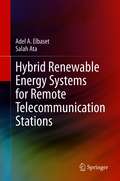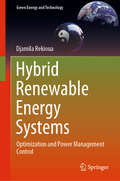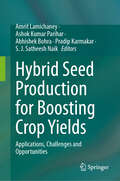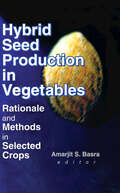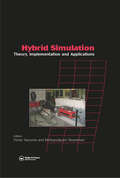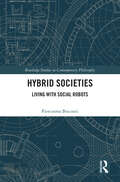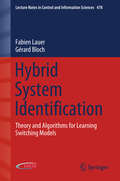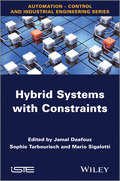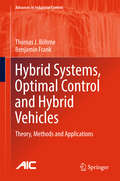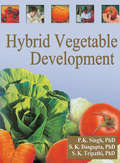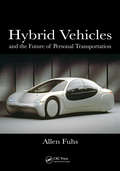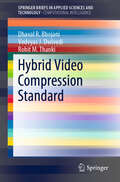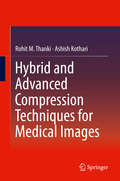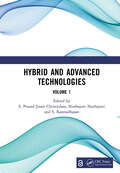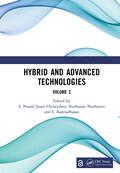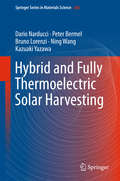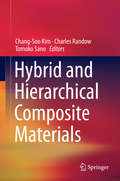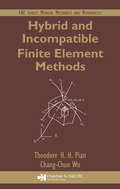- Table View
- List View
Hybrid Renewable Energy Systems for Remote Telecommunication Stations
by Adel A. Elbaset Salah AtaThis book looks at the challenge of providing reliable and cost-effective power solutions to expanding communications networks in remote and rural areas where grid electricity is limited or not available. It examines the use of renewable energy systems to provide off-grid remote electrification from a variety of resources, including regenerative fuel cells, ultracapacitors, wind energy, and photovoltaic power systems, and proposes a powerful hybrid system that can replace the need and high operation costs of batteries and diesel powered electric generators. Analyzes types of communications stations and their rate of consumption of electrical power;Presents brief descriptions of various types of renewable energy;Investigates renewable energy systems as a source for powering communication stations.
Hybrid Renewable Energy Systems: Optimization and Power Management Control (Green Energy and Technology)
by Djamila RekiouaThis book discusses the supervision of hybrid systems and presents models for control, optimization and storage. It provides a guide for practitioners as well as graduate and postgraduate students and researchers in both renewable energy and modern power systems, enabling them to quickly gain an understanding of stand-alone and grid-connected hybrid renewable systems. The book is accompanied by an online MATLAB package, which offers examples of each application to help readers understand and evaluate the performance of the various hybrid renewable systems cited. With a focus on the different configurations of hybrid renewable energy systems, it offers those involved in the field of renewable energy solutions vital insights into the control, optimization and supervision strategies for the different renewable energy systems.
Hybrid Seed Production for Boosting Crop Yields: Applications, Challenges and Opportunities
by Abhishek Bohra Ashok Kumar Parihar Amrit Lamichaney Pradip Karmakar S. J. Satheesh NaikThis book provides an overview of various procedures involved in hybrid seed production of field and vegetable crops, including historical development and principles, maintenance of seed purity of parental lines, evolution of breeding systems, male sterility and self-incompatibility. A section of the proposed book is dedicated to quality control procedures, comprising of purity testing, seed testing and certification process, and seed production management. The major shortcomings of the existing systems, new opportunities and future prospects of hybrid seed production are also discussed. The book focuses on field and vegetable crops like rice, maize, pearl millet, sorghum, pigeon pea, rapeseed, mustard, cotton, castor, soybean, and sunflower among others. This book is for students, researchers, and professionals working in the field of public sectors and commercial seed industries, as well as to other stakeholders who are working to improve their skills on hybrid seed production.
Hybrid Seed Production in Vegetables: Rationale and Methods in Selected Crops
by Amarjit S. BasraProduce hardy, high-yield vegetables with hybrid seeds!From the Preface, by Amarjit S. Basra: “The phenomenon of heterosis, also referred to as 'hybrid vigor,’underlies much of the improvement in crop yields achieved in the twentieth century. The exploitation of heterosis in crop production is of vital importance in facing the challenge of providing food and nutritional security for an ever-increasing human population.“The effective use of heterosis has fostered the development of a worldwide seed industry. Rapid advances in plant breeding and associated seed production technologies have served to enhance the competitiveness of hybrids by increasing crop and seed yield per hectare, reducing the costs involved, and improving seed quality.”Hybrid Seed Production in Vegetables: Rationale and Methods in Selected Crops will help crop scientists and growers increase the quality and yield of vegetables such as: cucumbers cabbage pumpkins squash peppers onions gourds and the fruits watermelon and winter melon. This valuable book provides up-to-date research about heterosis, cultivars, hybrids, and molecular markers to help you get the most quality and quantity out of your seeds. Containing suggestions and methods for overcoming male plant sterility, inbreeding, and challenges to pollination, Hybrid Seed Production in Vegetables will help you successfully breed hybrid plants to produce bountiful and healthy crops.
Hybrid Simulation: Theory, Implementation and Applications
by Victor Saouma Mettupulayam SivaselvanHybrid Simulation: Theory, Implementation and Applications deals with a rapidly evolving technology combining computer simulation (typically finite element) and physical laboratory testing of two complementary substructures. It is a multidisciplinary technology which relies heavily on control theory, computer science, numerical techniques and finds applications in aerospace, civil, and mechanical engineering.
Hybrid Societies: Living with Social Robots (Routledge Studies in Contemporary Philosophy)
by Piercosma BiscontiThis book explores how social robots and synthetic social agents will change our social systems and intersubjective relationships. It is obvious that technology influences societies. But how, and under what conditions do these changes occur? This book provides a theoretical foundation for the social implications of artificial intelligence (AI) and robotics. It starts from philosophy of technology, with a focus on social robotics, to systematically explore the concept of socio- technical change. It addresses two main questions: To what extent will social robots modify our social systems? And how will human relationality be affected by human–robot interactions? The book employs resources from continental philosophy, actor–network theory, psychoanalysis, systemic theory, and constructivist cognitive theory to develop a theory of socio-technical change. It also offers a novel perspective on how we should evaluate the effectiveness of social robots, which has significant implications for how social robotics should be researched and designed. Hybrid Societies will appeal to scholars and advanced students working in philosophy of technology, AI ethics, robot ethics, and continental philosophy.
Hybrid System Identification: Theory and Algorithms for Learning Switching Models (Lecture Notes in Control and Information Sciences #478)
by Fabien Lauer Gérard BlochHybrid System Identification helps readers to build mathematical models of dynamical systems switching between different operating modes, from their experimental observations. It provides an overview of the interaction between system identification, machine learning and pattern recognition fields in explaining and analysing hybrid system identification. It emphasises the optimization and computational complexity issues that lie at the core of the problems considered and sets them aside from standard system identification problems. The book presents practical methods that leverage this complexity, as well as a broad view of state-of-the-art machine learning methods.The authors illustrate the key technical points using examples and figures to help the reader understand the material. The book includes an in-depth discussion and computational analysis of hybrid system identification problems, moving from the basic questions of the definition of hybrid systems and system identification to methods of hybrid system identification and the estimation of switched linear/affine and piecewise affine models. The authors also give an overview of the various applications of hybrid systems, discuss the connections to other fields, and describe more advanced material on recursive, state-space and nonlinear hybrid system identification.Hybrid System Identification includes a detailed exposition of major methods, which allows researchers and practitioners to acquaint themselves rapidly with state-of-the-art tools. The book is also a sound basis for graduate and undergraduate students studying this area of control, as the presentation and form of the book provides the background and coverage necessary for a full understanding of hybrid system identification, whether the reader is initially familiar with system identification related to hybrid systems or not.
Hybrid Systems with Constraints (Wiley-iste Ser.)
by Sophie Tarbouriech Jamal Daafouz Mario SigalottiControl theory is the main subject of this title, in particular analysis and control design for hybrid dynamic systems. The notion of hybrid systems offers a strong theoretical and unified framework to cope with the modeling, analysis and control design of systems where both continuous and discrete dynamics interact. The theory of hybrid systems has been the subject of intensive research over the last decade and a large number of diverse and challenging problems have been investigated. Nevertheless, many important mathematical problems remain open. This book is dedicated mainly to hybrid systems with constraints; taking constraints into account in a dynamic system description has always been a critical issue in control. New tools are provided here for stability analysis and control design for hybrid systems with operating constraints and performance specifications. Contents 1. Positive Systems: Discretization with Positivity and Constraints, Patrizio Colaneri, Marcello Farina, Stephen Kirkland, Riccardo Scattolini and Robert Shorten. 2. Advanced Lyapunov Functions for Lur’e Systems, Carlos A. Gonzaga, Marc Jungers and Jamal Daafouz. 3. Stability of Switched DAEs, Stephan Trenn. 4. Stabilization of Persistently Excited Linear Systems, Yacine Chitour, Guilherme Mazanti and Mario Sigalotti. 5. Hybrid Coordination of Flow Networks, Claudio De Persis, Paolo Frasca. 6. Control of Hybrid Systems: An Overview of Recent Advances, Ricardo G. Sanfelice. 7. Exponential Stability for Hybrid Systems with Saturations, Mirko Fiacchini, Sophie Tarbouriech, Christophe Prieur. 8. Reference Mirroring for Control with Impacts, Fulvio Forni, Andrew R. Teel, Luca Zaccarian. About the Authors Jamal Daafouz is an expert in the area of switched and polytopic systems and has published several major results in leading journals (IEEE TAC, Automatica, Systems and Control Letters, etc.). He serves as an Associate Editor for the key journal IEEE TAC and is a member of the Editorial Board of the IEEE CSS society. Sophie Tarbouriech is an expert in the area of nonlinear systems with constraints and has published several major results in leading journals (IEEE TAC, Automatica, Systems and Control Letters, etc.) and books. She is a member of the Editorial Board of the IEEE CSS society and has also served as an Associate Editor for the key journal IEEE TAC. Mario Sigalotti is an expert in applied mathematics and switched systems and has published several results in leading journals (IEEE TAC, Automatica, Systems and Control Letters, etc.). He heads the INRIA team GECO and is a member of the IFAC Technical Committee on Distributed Parameter Systems.
Hybrid Systems, Optimal Control and Hybrid Vehicles
by Thomas J. Böhme Benjamin FrankThis book assembles new methods showing the automotive engineer for the first time how hybrid vehicle configurations can be modeled as systems with discrete and continuous controls. These hybrid systems describe naturally and compactly the networks of embedded systems which use elements such as integrators, hysteresis, state-machines and logical rules to describe the evolution of continuous and discrete dynamics and arise inevitably when modeling hybrid electric vehicles. They can throw light on systems which may otherwise be too complex or recondite. Hybrid Systems, Optimal Control and Hybrid Vehicles shows the reader how to formulate and solve control problems which satisfy multiple objectives which may be arbitrary and complex with contradictory influences on fuel consumption, emissions and drivability. The text introduces industrial engineers, postgraduates and researchers to the theory of hybrid optimal control problems. A series of novel algorithmic developments provides tools for solving engineering problems of growing complexity in the field of hybrid vehicles. Important topics of real relevance rarely found in text books and research publications--switching costs, sensitivity of discrete decisions and there impact on fuel savings, etc. --are discussed and supported with practical applications. These demonstrate the contribution of optimal hybrid control in predictive energy management, advanced powertrain calibration, and the optimization of vehicle configuration with respect to fuel economy, lowest emissions and smoothest drivability. Numerical issues such as computing resources, simplifications and stability are treated to enable readers to assess such complex systems. To help industrial engineers and managers with project decision-making, solutions for many important problems in hybrid vehicle control are provided in terms of requirements, benefits and risks.
Hybrid Vegetable Development
by Praveen K Singh Shaibal K Dasgupta Subodh K TripathiGet all the resource information you need on hybrid vegetable developmentin one book!Discover the latest concepts in breeding and development of hybrid vegetables with Hybrid Vegetable Development. Respected authorities share their views on the most recent trends and the techniques used for hybrid vegetable development in various
Hybrid Vehicles: and the Future of Personal Transportation
by Allen FuhsUncover the Technology behind Hybrids and Make an Intelligent Decision When Purchasing Your Next Vehicle With one billion cars expected to be on the roads of the world in the near future, the potential for war over oil and the negative environmental effects of emissions will be greater than ever before. Now is the time to seriously consider an alte
Hybrid Video Compression Standard (SpringerBriefs in Applied Sciences and Technology)
by Rohit M. Thanki Vedvyas J. Dwivedi Dhaval R. BhojaniThe book presents compression techniques for digital video stream, describing their design using various image transforms, such as discrete cosine transform (DCT), discrete wavelet transform (DWT), and singular value decomposition (SVD). It first discusses the basic requirements and applications of video compression techniques. The book then addresses video compression using DCT as well as the hybrid compression technique, designed and implemented using DCT, DWT and SVD, demonstrating the simulation results for both. Lastly, it proposes future research directions in the field.
Hybrid and Advanced Compression Techniques for Medical Images
by Rohit M. Thanki Ashish KothariThis book introduces advanced and hybrid compression techniques specifically used for medical images. The book discusses conventional compression and compressive sensing (CS) theory based approaches that are designed and implemented using various image transforms, such as: Discrete Fourier Transform (DFT), Discrete Cosine Transform (DCT), Discrete Wavelet Transform (DWT), and Singular Value Decomposition (SVD) and greedy based recovery algorithm. The authors show how these techniques provide simulation results of various compression techniques for different types of medical images, such as MRI, CT, US, and x-ray images. Future research directions are provided for medical imaging science. The book will be a welcomed reference for engineers, clinicians, and research students working with medical image compression in the biomedical imaging field. Covers various algorithms for data compression and medical image compression;Provides simulation results of compression algorithms for different types of medical images;Provides study of compressive sensing theory for compression of medical images.
Hybrid and Advanced Technologies: Proceedings of the International Conference on Hybrid and Advanced Technologies (ICHAT 2024), April 26-28, 2024, Ongole, Andhra Pradesh, India (Volume 1)
by S. Kannadhasan Jones Christydass, S. Prasad Nurhayati NurhayatiThe proceedings of the International Conference on Hybrid and Advanced Technologies (ICHAT 2024) present a rich repository of cutting-edge research on the various applications of machine learning, deep learning and AI in cybersecurity, healthcare, agriculture and communication systems.It highlights the revolutionary potential of data science in transforming traditional practices, improving efficiency and accuracy across diverse domains and addressing complex real-world challenges. These proceedings contain innovative neural-network models for agriculture that can predict tractor fuel consumption and optimize smart irrigation, besides suggesting greenhouse automation for enhanced agricultural productivity. It also provides a roadmap for IoT-based monitoring systems for asthma patients and machine learning approaches for early detection of diabetes, cancer and aquatic plant ailments. Through an array of practical examples and comparative studies, the book further highlights advancements in machine learning for enhancing palm vein authentication, combating fake news, keeping data safe and improving customer segmentation in e-commerce. The findings would be instrumental in combating critical global issues and foster a deeper understanding of the role of AI in image processing, cybersecurity, medical diagnostics and intelligent systems in the future.This will be a highly interesting guide to researchers, data scientists and practicing professionals in the fields of artificial intelligence, machine learning and cybersecurity. It will also be of interest to healthcare professionals, agricultural scientists and technology enthusiasts in fostering global collaborations, exploring future challenges and opportunities and introducing state-of-the-art technologies to streamline processes.
Hybrid and Advanced Technologies: Proceedings of the International Conference on Hybrid and Advanced Technologies (ICHAT 2024), April 26-28, 2024, Ongole, Andhra Pradesh, India (Volume 2)
by S. Kannadhasan Jones Christydass, S. Prasad Nurhayati NurhayatiThe proceedings of the International Conference on Hybrid and Advanced Technologies (ICHAT 2024) present a rich repository of cutting-edge research on the various applications of machine learning, deep learning, and AI in cybersecurity, healthcare, agriculture and communication systems.It highlights the revolutionary potential of data science in transforming traditional practices, improving efficiency and accuracy across diverse domains and addressing complex real-world challenges. These proceedings contains innovative neural-network models for agriculture that can predict tractor fuel consumption and optimize smart irrigation, besides suggesting greenhouse automation for enhanced agricultural productivity. It also provides a roadmap for IoT-based monitoring systems for asthma patients and machine learning approaches for early detection of diabetes, cancer and aquatic plant ailments. Through an array of practical examples and comparative studies, the book further highlights advancements in machine learning for enhancing palm vein authentication, combating fake news, keeping data safe and improving customer segmentation in e-commerce. The findings would be instrumental in combating critical global issues and foster a deeper understanding of the role of AI in image processing, cybersecurity, medical diagnostics, and intelligent systems in the future.This will be a highly interesting guide to researchers, data scientists, and practicing professionals in the fields of artificial intelligence, machine learning, and cybersecurity. It will also be of interest to healthcare professionals, agricultural scientists, and technology enthusiasts in fostering global collaborations, exploring future challenges and opportunities and introducing state-of-the-art technologies to streamline processes.
Hybrid and Fully Thermoelectric Solar Harvesting
by Ning Wang Dario Narducci Peter Bermel Bruno Lorenzi Kazuaki YazawaThis book provides a comprehensive overview on fully thermal and hybrid solar generators based on thermoelectric devices. The book fills a gap in the literature on solar conversion and thermoelectrics, because despite the growing number of papers dealing with the use of thermoelectrics in solar power conversion, no book exists for PV specialists or thermoelectricity experts to enter this field. The book is intended as a primer for scientists or engineers willing to complement their expertise in one of the two fields, and to get an updated, critical review of the state of the art in thermoelectric solar harvesting.
Hybrid and Hierarchical Composite Materials
by Chang-Soo Kim Charles Randow Tomoko SanoThis book addresses a broad spectrum of areas in both hybrid materials and hierarchical composites, including recent development of processing technologies, structural designs, modern computer simulation techniques, and the relationships between the processing-structure-property-performance. Each topic is introduced at length with numerous and detailed examples and over 150 illustrations. In addition, the authors present a method of categorizing these materials, so that representative examples of all material classes are discussed.
Hybrid and Incompatible Finite Element Methods (Modern Mechanics and Mathematics)
by Theodore H.H. Pian Chang-Chun WuWhile the theory and application of finite elements methods can be extended to incompatible, hybrid, and mixed element methods, important issues, such as determining the reliability of the solution of incompatible multivariable elements, along with a common perception of impracticality, have hindered the widespread implementation of these methods.
Hybrid and Networked Dynamical Systems: Modeling, Analysis and Control (Lecture Notes in Control and Information Sciences #493)
by Luca Zaccarian Elena Panteley Paolo Frasca Romain PostoyanHybrid and Networked Dynamical Systems treats a class of systems that is ubiquitous in everyday life. From energy grids to fleets of robots or vehicles to social networks to biological networks, the same scenario arises: dynamical units interact locally through a connection graph to achieve a global task. The book shows how analysis and design tools can be adapted for control applications that combine the effects of network-induced interactions and hybrid dynamics with complex results.Following a scene-setting introduction, the remaining 12 chapters of the book are divided into three parts and provide a unique opportunity to describe the big picture that is the culmination of years of recent research activity. The contributing authors expand on their ideas at greater length than is possible in an archival research paper and use in-depth examples to illustrate their theoretical work.The widespread importance of hybrid and networked systems means that the book is of significant interest to academic researchers working in applied mathematics, control, and electrical, mechanical and chemical engineering and to their industrial counterparts.
Hybrid-Energy Cutting of Aerospace Alloys
by Guolong Zhao Wenfeng Ding Biao Zhao Ning Qian Moran Xu Yanbin Zhang Daohui XiangThis book pioneers the exploration of hybrid-energy cutting for aerospace alloys, summarizing cutting-edge research on laser-assisted, ultrasonic vibration-assisted, electrical-assisted, and hybrid-energies-assisted cutting. It also covers enhanced heat transfer in cutting processes, proposing novel technologies for achieving geometric precision and surface integrity at low costs. The book delves into multi-energy fields interaction mechanisms, material removal, tool wear, and cutting performance of aerospace alloys, alongside green and high-efficient cooling technologies. Targeting researchers, scientists, engineers, and professionals in aerospace, materials science, mechanical engineering, and manufacturing, this advanced-level resource assumes a solid background in engineering and materials science. It provides detailed discussions on theoretical aspects and practical applications of hybrid-energy cutting techniques. This book is a valuable reference for advanced researchers and practitioners in aerospace alloys cutting. It provides a comprehensive exploration of hybrid-energy technologies, detailed insights into mechanisms and performance, and a focus on sustainable and cost-effective cutting solutions.
Hybrid-Energy Sustainable Machining: Mechanism and Processability
by Changhe Li Yanbin ZhangThis book explores the machinability mechanism of hard-to-machining materials under hybrid energy field, with a particular emphasis on the development and modification of green lubricants, the integration of multi-energy field assistance, and the intelligent machining equipment. It offers a comprehensive overview of cleaner precision manufacturing techniques, multi-energy assisted processing applications, and sustainable manufacturing practices, presenting innovative strategies for energy conservation, emission reduction, and the advancement of an eco-friendly society. By enhancing the sustainable use of bio-lubricants in intelligent machining and utilizing multi-energy field assistance to improve grinding and turning performance, this book provides a green, clean, and precise machining approach that prioritizes environmental protection, resource efficiency, and energy sustainability, while addressing the compatibility challenges between intelligent machining systems and clean energy applications.
Hybrid-Nanomaterials: Fabrication, Characterization and Applications (Engineering Materials)
by Subash C. B. Gopinath Muhammad Mahyiddin RamliThis book highlights the importance of surface nanomaterials for analytical applications and diagnostics. As widely been stated, surface is the base for all downstream analytical applications and the incorporation of additional material to form a hybrid makes a drastic improvement in the performance of the surfaces. Even though, metallic hybrid materials play a pivotal role, non-metallic and metallic hybrid materials yield new avenues. Characterization of these hybrid nanomaterials provides a detailed insight, which attests to new inventions and novel materials. Hybrid nanomaterials are characterized by analytical systems and to generate the analytical systems hybrid materials are essential. The potential of hybrid nanomaterials exists within various interdisciplinary sciences including medicine, which this book presents.
Hybridfahrzeuge: Grundlagen, Komponenten, Fahrzeugbeispiele
by Peter HofmannDas Buch beschreibt ausführlich, beginnend mit der geschichtlichen Entwicklung, die verschiedenen Arten und Klassifizierungen von Hybridfahrzeugen. Es wird ferner detailliert dargestellt, wie und in welchen Bereichen Verbesserungen und zusätzliche Funktionalitäten durch die Hybridantriebstechnologie in Fahrzeugen ermöglicht werden.Eine genaue Erläuterung der Einzelkomponenten und deren Funktionen sowie Beispiele für Antriebsstrangmanagement und Betriebsstrategien vermitteln dem Leser das Verständnis für das Potential von Hybridantriebssträngen. Eine umfassende Beschreibung und Erklärung von repräsentativen Beispielen aller Topologien von ausgeführten Hybridfahrzeugen im PKW-Sektor schließen das Buch ab.Die 3. Auflage berücksichtigt nicht nur die seit Erscheinen der zweiten Auflage erreichten Fortschritte auf allen Teilgebieten, sondern auch zahlreiche Anregungen der Leser. Ein besonderer Fokus wird auf die zukünftige Bedeutung von Hybridfahrzeugen gelegt, die bei Einsatz von regenerativ hergestellten Kraftstoffen (E-Fuels) niedrigere CO2-Gesamtemissionen aufweisen als Batterie Elektrische Fahrzeuge (BEV) auch bei Einsatz von regenerativ hergestelltem Strom.Bestens geeignet als Lehrbuch für Studierende des Maschinenbaus und der Kraftfahrzeugtechnik sowie als Fachbuch für Ingenieure, die sich ein fachübergreifendes Wissen in den verschiedenen Themenbereichen der Hybridfahrzeuge aneignen wollen.
Hybridized and Coupled Nanogenerators: Design, Performance, and Applications
by Ya YangA comprehensive guide to efficiently scavenge multi-energies from the surrounding environment to power some electronic devices and realize self-powered sensing! With the advantages of high-integration level, low cost, and high-conversion efficiency, hybridized nanogenerators have many potential applications in multi-energy scavenging and sensor fields. This book offers a comprehensive review of the design, performance, and applications of hybridized and coupled nanogenerators. The author—a noted expert on the topic—explores the various new hybridized and multi-effects coupled nanogenerators. The book examines the current approaches of improving electric generation performance and offers an introduction to the applications of hybridized nanogenerators in energy harvesting and sensing. This technology has proven to be highly applicable in multi-energy scavenging and self-powered sensor fields. This book includes: Examines the potential applications of hybridized and coupled nanogenerators in multi-energy scavenging and sensor fields Covers the principles of device design Explores the most current approaches to improve performance Reviews various multi-effects coupled nanogenerators and their potential applications Written for materials scientists, engineering scientists, electronics engineers, bioengineers, sensor developers, and sensor industry professionals, This book is a guide to hybridized and coupled nanogenerators that achieve the maximum utilization of multi-type and stable energies.
Hybridizing Surface Probe Microscopies: Toward a Full Description of the Meso- and Nanoworlds
by Susana Moreno-Flores Jose L. Toca-HerreraMany books and reviews about scanning probe microscopies (SPM) cover the basics of their performance, novel developments, and state-of-the-art applications. Taking a different approach, Hybridizing Surface Probe Microscopies: Towards a Full Description of the Meso- and Nanoworlds encompasses the technical efforts in combining SPM with spectroscopic and optical complementary techniques that, altogether, provide a complete description of nanoscale and mesoscale systems and processes from corrosion to enzymatic reactions. The book is organized into eight chapters, following a general scheme that revolves around the two main capabilities of SPM: imaging and measuring interactions. Each chapter introduces key theoretical concepts and basic equations of the particular stand-alone technique with which the scanning probe microscopies are combined. Chapters end with the SPM-technique combination and some real-world examples in which the combination has been devised or used. Most chapters include a historical review of the techniques and numerous illustrations to support key ideas and provide the reader with intuitive understanding. To understand the limitations of any technique also means to understand how this technique works. This book has devoted a considerable amount of space in explaining the basics of each technique as they are being introduced. At the same time, it avoids explaining the particularities of each SPM-based technique and opts for a rather generalized approach. In short, the book’s focus is not on what SPM can do, but rather on what SPM cannot do and, most specifically, on presenting the experimental approaches that circumvent these limitations.
